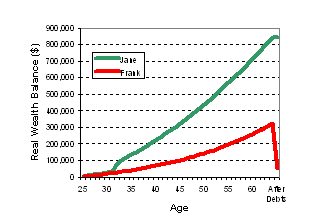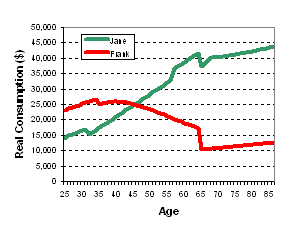A person earning $36,000 could be $790,000 better off over their working life by improving their understanding of money and by becoming more financially literate.
The new figures, based on Treasury modelling, were released at the launch of a Federal Government initiative aimed at helping Australians to improve their financial decision-making skills.
The Financial Literacy Foundation was officially unveiled by the Minister for Revenue and Assistant Treasurer, Mal Brough today. The Foundation will be chaired by respected money commentator Paul Clitheroe, and will include an advisory board of 10 high-profile Australians.
'The Foundation will foster strategic partnerships with public, private and community sector organisations to encourage active support of its goal to raise community awareness of financial literacy,' Mal Brough said today.
Speaking at the official launch at Alexandra Hills High School in Brisbane, Mr Brough said establishing the Financial Literacy Foundation demonstrated the Government's commitment to helping all Australians to make informed decisions and make the most of their money.
'By improving financial literacy levels, we will help Australians increase their financial knowledge and better understand their options, and the choices they can make to manage their money. It is important that all people — children, teenagers, young adults, older adults and retirees — are better informed about their financial future.'
The work of the Financial Literacy Foundation will include:
- running an Australia-wide information and awareness-raising campaign;
- incorporating financial literacy programmes in schools and workplaces; and
- setting up a one-stop website to serve as a portal for financial literacy education and information.
'It is important that we recognise that it is never too early, or for that matter too late, to start thinking about budgeting, saving and investing,' Mr Brough said.
'We are fortunate to have Paul Clitheroe as the Chairman of the Foundation, as he not only brings his expert knowledge of finance to the Board, but also his personal commitment to seeing all Australians more knowledgeable and aware of their financial options.'
The other Advisory Board members are leaders in their respective fields and include:
- Craig Dunn
Managing Director, AMP Australian Financial Services - Linda Elkins
General Manager, Communication and Education, Sunsuper
Managing Director, Communi(k) Australia - Michael Hawker
Chief Executive Officer and Managing Director, Insurance Australia Group - Elaine Henry OAM
Chief Executive Officer, The Smith Family - Peter Kell
Chief Executive Officer, Australian Consumers' Association - Kerrie Kelly
Chief Executive Officer, Financial Planning Association of Australia Limited - Margaret Kilby OAM
Educator, Rotary Youth Driver Awareness - John McFarlane
Chief Executive Officer, Australia and New Zealand Banking Group Limited - Ken Smith
Director General, Queensland Department of Education and the Arts
For more information visit www.understandingmoney.gov.au.
Treasury modelling available at www.assistant.treasurer.gov.au.
Media contacts:
Carlie Hogan (Minister's Office) - 0408 960 905
Sally Webster (Financial Literacy Foundation) - 0432 970 930
ATTACHMENT
TREASURY MODELLING SHOWS THE EFFECT OF FINANCIAL DECISION MAKING
The Case for Improved Financial Literacy
Treasury modelling demonstrates how a person earning $36,000 a year throughout the course of their working life could be better off by more than $790,000 by following a few simple financial basics.
Methodology
In order to model case studies for the Financial Literacy Foundation, Treasury's Retirement and Income Modelling (RIM) Unit has developed a comprehensive hypothetical model of income and wealth accumulation during working life.
The model uses several components to project real spending money and the real accumulation of wealth through a working life of 40 years, showing the impact of individual financial decisions made over this period of time. At the point of retirement, the model is integrated with the well established RIMHYPO model of the RIM Unit, thus enabling real disposable incomes during the retirement phase to be projected, fully accounting for income tax and age pension interactions.
The model incorporates a range of plausible parameter values. However, projections for such extended periods of time must be regarded as indicative rather than definitive.
A Few Financial Basics
A few good financial habits can make a big difference to the amount of spending money and wealth individuals can have. For instance, a person could be more than $790,000 better off over their working life by early and regular saving, and being mindful of their use of debt.
We have modelled and compared different financial decisions made by two people earning $36,000 over a 40-year working life. By saving and putting her money into a property and avoiding paying interest on credit cards, Jane not only has substantially more wealth — she also has more lifestyle choices with fewer money worries and more spending money.
Alternatively, Frank who uses his credit card to pay for everyday items, finds that as time goes on, more of his income goes towards paying off debt rather than supporting his lifestyle. At the end of their working lives, Jane is more than $790,000 better off than Frank, which is a very substantial return for following a few simple financial basics.
How Jane Creates Wealth of $840,000
From the age of 25, Jane manages to save $125 a week, so by the time she is 32 she has a $50,000 deposit saved for a property worth $250,000.
If she repays the loan over 25 years with monthly repayments of around $1,400, we estimate that Jane could have her mortgage paid off by the time she is 57. At this stage, Jane decides to put an extra $200 a week towards her superannuation.
Jane wants to be financially secure when she retires, so she chooses to save an extra $10 a week as a voluntary superannuation contribution. As she qualifies for the Government co-contribution, she gets an extra $15 a week until she is 43 and a part co-contribution until she is 53.
Importantly, she also makes sure that she pays the full amount off her credit card each month and does not have a personal loan. This means Jane may have less of a disposable income in the short term by putting money away and paying off her credit cards. However, she doesn't get bogged down with large interest payments and will actually have more spending money later on.
When Jane is 65 she is projected to have a real-wealth balance of over $840,000, which includes the value of her property. This is because her wealth has accumulated over time, her property has increased in value and she has earned interest on a growing amount of savings.
How Frank Misses Out
Frank lives by the 'buy now and pay later' approach. He is happy to buy the things he wants on credit. He doesn't make more than the regular monthly re-payments on his credit card to cover his expenditure and the interest. By the time he is 35, Frank has a credit card debt of around $20,000.
Frank doesn't buy a property and continues to rent, he chooses to fund his lifestyle by taking out personal loans. By age 46, more and more of Frank's income is going into paying the interest on his credit card and loan interest payments. The amount of money he has to spend is decreasing. At the same stage, Jane already has a greater disposable income than Frank.
By the time he is 65, Frank has a credit card debt of $8,000 and personal loan debts of $255,000 (in real terms). His superannuation payout will go toward paying off his debts, which means Frank's projected wealth may only be around $52,000, more than $790,000 less than Jane.
|
Chart 1: Comparison of Jane and Frank's |
Chart 2: Comparison of Jane and Frank's |
|
Chart 1: The key point about accumulating wealth is that it gets easier as your savings grow. Because interest is earned on a bigger amount, more interest is earned, which when rolled back in the balance results in a bigger balance and more interest, and so on. |
Chart 2: The message from this chart is that Jane is actually able to spend more than Frank, even though she also saves more and has earned the same gross (and disposable) income. The reason for this is that Jane does not lose money to rent and interest on credit cards or personal loans. |


